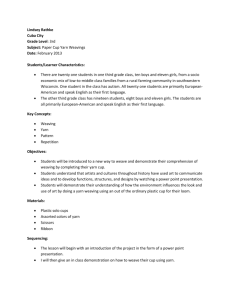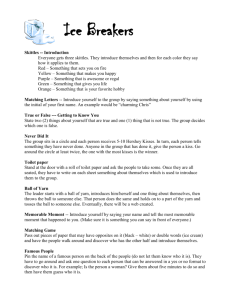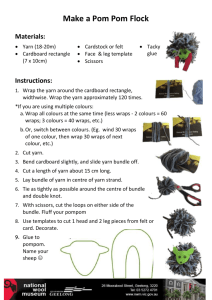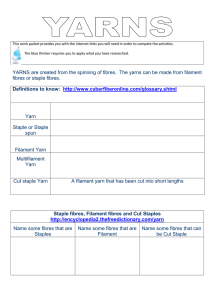n Introduction
advertisement
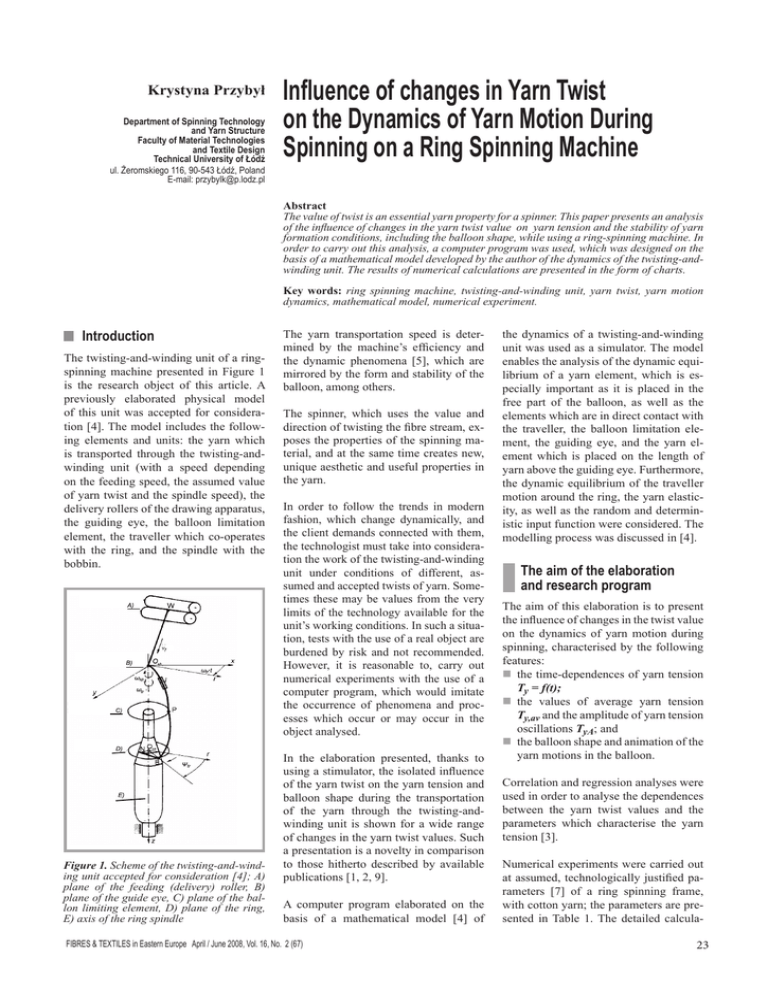
Krystyna Przybył Department of Spinning Technology and Yarn Structure Faculty of Material Technologies and Textile Design Technical University of Łódź ul. Żeromskiego 116, 90-543 Łódź, Poland E-mail: przybylk@p.lodz.pl Influence of changes in Yarn Twist on the Dynamics of Yarn Motion During Spinning on a Ring Spinning Machine Abstract The value of twist is an essential yarn property for a spinner. This paper presents an analysis of the influence of changes in the yarn twist value on yarn tension and the stability of yarn formation conditions, including the balloon shape, while using a ring-spinning machine. In order to carry out this analysis, a computer program was used, which was designed on the basis of a mathematical model developed by the author of the dynamics of the twisting-andwinding unit. The results of numerical calculations are presented in the form of charts. Key words: ring spinning machine, twisting-and-winding unit, yarn twist, yarn motion dynamics, mathematical model, numerical experiment. nIntroduction The twisting-and-winding unit of a ringspinning machine presented in Figure 1 is the research object of this article. A previously elaborated physical model of this unit was accepted for consideration [4]. The model includes the following elements and units: the yarn which is transported through the twisting-andwinding unit (with a speed depending on the feeding speed, the assumed value of yarn twist and the spindle speed), the delivery rollers of the drawing apparatus, the guiding eye, the balloon limitation element, the traveller which co-operates with the ring, and the spindle with the bobbin. Figure 1. Scheme of the twisting-and-winding unit accepted for consideration [4]; A) plane of the feeding (delivery) roller, B) plane of the guide eye, C) plane of the ballon limiting element, D) plane of the ring, E) axis of the ring spindle The yarn transportation speed is determined by the machine’s efficiency and the dynamic phenomena [5], which are mirrored by the form and stability of the balloon, among others. The spinner, which uses the value and direction of twisting the fibre stream, exposes the properties of the spinning material, and at the same time creates new, unique aesthetic and useful properties in the yarn. In order to follow the trends in modern fashion, which change dynamically, and the client demands connected with them, the technologist must take into consideration the work of the twisting-and-winding unit under conditions of different, assumed and accepted twists of yarn. Sometimes these may be values from the very limits of the technology available for the unit’s working conditions. In such a situation, tests with the use of a real object are burdened by risk and not recommended. However, it is reasonable to, carry out numerical experiments with the use of a computer program, which would imitate the occurrence of phenomena and processes which occur or may occur in the object analysed. In the elaboration presented, thanks to using a stimulator, the isolated influence of the yarn twist on the yarn tension and balloon shape during the transportation of the yarn through the twisting-andwinding unit is shown for a wide range of changes in the yarn twist values. Such a presentation is a novelty in comparison to those hitherto described by available publications [1, 2, 9]. A computer program elaborated on the basis of a mathematical model [4] of FIBRES & TEXTILES in Eastern Europe April / June 2008, Vol. 16, No. 2 (67) the dynamics of a twisting-and-winding unit was used as a simulator. The model enables the analysis of the dynamic equilibrium of a yarn element, which is especially important as it is placed in the free part of the balloon, as well as the elements which are in direct contact with the traveller, the balloon limitation element, the guiding eye, and the yarn element which is placed on the length of yarn above the guiding eye. Furthermore, the dynamic equilibrium of the traveller motion around the ring, the yarn elasticity, as well as the random and deterministic input function were considered. The modelling process was discussed in [4]. The aim of the elaboration and research program The aim of this elaboration is to present the influence of changes in the twist value on the dynamics of yarn motion during spinning, characterised by the following features: n the time-dependences of yarn tension Ty = f(t); n the values of average yarn tension Ty,av and the amplitude of yarn tension oscillations TyA; and n the balloon shape and animation of the yarn motions in the balloon. Correlation and regression analyses were used in order to analyse the dependences between the yarn twist values and the parameters which characterise the yarn tension [3]. Numerical experiments were carried out at assumed, technologically justified parameters [7] of a ring spinning frame, with cotton yarn; the parameters are presented in Table 1. The detailed calcula- 23 Table 1. Experiment parameters. Parameter ωtr = (ωsp • rb – vf)/rb Symbol Unit Value Linear density of the cotton yarn Tty tex = mg/m 12 Yarn twist Twy rotations per meter 400 - 1370 αTt - 1386 - 4743 44 - 150 Twist coefficient αNm - Linear speed of yarn delivery vf m/minute 7 - 25 Coefficient of air resistance Cr - 0,96 [1] Coefficient of kinetic friction of the pair: yarn – steel µy - 0,29 [4] Traveller mass mtr g 0,052 Spindle rotary speed nsp r.p.m. 167 Balloon height Hbl m Minimum bobbin radius rb,min m Maximum bobbin radius rb,max m tions were based on the constructional parameters of the PJ ring spinning frame, produced in Poland. The simulation was carried out for an object characterised by a deterministic basic input function, determined by the particular construction of the twistingand-winding unit [4]. At normal working conditions of the spinning frame, change in the twist value Twy is realised only by altering and next setting the feeding speed vf of the delivery rollers of the drawing apparatus. The rotary speed nsp of the spindles is constant at the same time. In order to present the influence of changes in the twist value, obtained by changing the feeding speed, on the dynamics of yarn motion, numerical experiments were carried out for selected parameters, listed in Table 1. nTheoretical considerations Traveller B, which moves around the raceway of the ring with an angular speed ωtr,twists the fibre stream fed with the speed vf, at the same creating forces which determine the yarn tension value Ty. The tension is distributed along the whole yarn segment, which is transported through the twisting-and-winding unit [1, 2, 9, 10]. During the manufacturing of yarn, its tension and the shape of the balloon are determined by the working parameters of the unit. The change in these parameters, resulting from the tasks performed, cause a change in the ratio of the forces acting on a rotating yarn segment, as well as in the total yarn tension Ty. This raises the question of how the twist value changes, 24 The longitudinal cross-section area Syi of the elementary yarn segment ‘i’ of length ∆li connected with its diameter dyi equals: Syi = dy i• ∆li (3) Where the yarn diameter is determined by the Pierce [12] equation: in relation to the bobbin’s base especially over a wide range of values, as well as how it influences the dynamics of yarn motion, characterised by the dependency of yarn tension on time and balloon shape. In order to find an answer to this question, the forces acting on a rotating elementary yarn segment, which are displayed in Figure 2, and their changes (resulting in the yarn twist value analysed) were calculated, and next a numerical experiment was carried out which showed the influence of twist on the dynamics of yarn motion. According to Figure 2, it is not only the forces of tensions Ty and (Ty + dTy), the latter being the reaction of the neighbouring yarn elements, which act on the rotating yarn element ‘i’, but also the following differential forces: the air resistance dFa, the centrifugal force dFcen, the Coriolis force dFCs, and the yarn inertia force dFy,in. The forces of air resistance Fa (and at the same dFa) are proportional to the square of the actual yarn speed, as well as to the longitudinal cross-section area of the yarn element, and the yarn resistance coefficient. According to Figure 3, the vector of the yarn velocity vy is the sum of the vector of the rotating speed (ωtr × ri) of the traveller and the vector of the feeding speed vf vy = (ωtr × ri) + vf (2) dy = (4 • Tty / πρy)1/2 (4) where: ρy – is the yarn’s material density, which is proportional to the twist coefficient αTt, described by the Barella dependence [12]: ρy = 600 + 85.4 • αTt, in kg/m3 (5) Considering the changes in the value of the air resistance force Fa, as Figure 2. Forces acting on the element /i / of the yarn segment within the balloon. (1) where: ri – is the radius-vector of the yarn element ‘i’. The rotary speed ωtr of the traveller is connected with the assumed rotary spindle speed ωsp and the actual bobbin radius rb by the equation: Figure 3. Direction of the speed vector vy = (ωtr × ri) + vf of the elementary ‘i’ segment of yarn within the balloon, which is the sum of the rotary speed vector (ωtr × ri) and the yarn feeding speed vector vf. FIBRES & TEXTILES in Eastern Europe April / June 2008, Vol. 16, No. 2 (67) the consequence of changes in the yarn feeding speed, we can state that the yarn speed of its rotary motion (ωtr × ri) is significantly greater than its feeding speed vf, which may be described by: ωtr × ri >> vf (6) Therefore, we may assume that a numerical experiment carried out with separated values of the feeding speed vf,as a way of realising the assumed set twist values Twy, will not create essential changes in the air resistance force. On the other hand, while analysing the centrifugal force Fcen, which acts on the yarn element ‘i’ (dFcen,), we can state that it is proportional to the mass of the element ∆mi, radius vector ri, and yarn feeding speed vf. From the previous considerations it can be observed that the feeding speed is significantly smaller than the peripheral speed (ωtr × ri), and what is more, the radius of the balloon’s curvature rb,c is much greater than the radius vector ri,,and hence the following dependency may be given: vf2 / rb,c << ωtr2× ri (7) Thus, a conclusion can be drawn that changes in the feeding speed vf do not cause significant alterations in the value of the yarn’s centrifugal force. The subsequent force, whose value will vary with a change in the yarn feeding speed vf.,is a Corriolis force, described by the dependency: FCr = ∆mi • (2vf × ωtr) (8) Equation (8) proves that the significance of the feeding speed for value FCr rises with its increase. However, when the feeding speed is relatively low, characteristic of a ring-spinning frame, it only has a secondary, unimportant influence on the Corriolis force. The changes in the parameters of the twisting-and-winding unit, as well as differences in yarn parameters, which may be caused by e.g. yarn irregularity, result in disturbances of the yarn segment movement as it is guided through the unit. They were considered while designing the model by including the yarn inertia force Fy,in in its mathematical characteristicin the form of the quotient of the mass of the elementary element of the yarn segment and its acceleration. The above- presented analysis of forces acting on the yarn element allows to state that the air resistance force Fa has the greatest importance for the value of yarn tension Ty, which is in agreement with research results presented in [1, 2, 10]. As was demonstrated, the yarn feeding speed vf of a ring-spinning frame is significantly smaller than the yarn’s peripheral speed (ωtr × ri) in the ascending motion. Therefore, we may predict that a change in the twist value within a very wide range, caused by a change in the yarn feeding speed, would not cause disturbances of the stability of yarn manufacturing conditions. The quantitative evaluation of the influence of yarn twist on the balloon’s shape and yarn tension by measuring the actual values of the real object is very difficult, as the reaction of the twisting-and-winding unit and the yarn is a complex, confounding function of the unit’s and yarn parameters as well as their irregularities and imperfections. Thus, a need arises to use a simulator to visualise the isolated influence of changes in yarn twist on the dynamics of yarn motion. Presentation of simulation results. As a result of the simulation investigations carried out, a lot of numerical data and charts were obtained which illustrate changes in the yarn tension and balloon shape as functions of time. Considering the great amount of results obtained and the limited space in this article, only four time dependences of the tension Ty =f(t) are presented in Figures 4 – 7. In Figure 4 a time-dependence is presented at the minimum twist value of Twy = 400 t.p.m. (expressed by rotations per metre), caused by the maximum yarn feeding speed of vf = 25 m/minute. For the experiment carried out, the character of changes in the average tension value Ty,av and the yarn tension amplitude Ty,A, which are a result of a change in the twist value (∆Twy) within the whole range of values accepted, are graphically presented in Figures 5 and 7 for the cases of winding yarn at the maximum and minimum radii of the bobbin. FIBRES & TEXTILES in Eastern Europe April / June 2008, Vol. 16, No. 2 (67) Verification of the statistical hypothesis of the correlation significance between Twy and Ty,av, as well as between Twy and Ty,A at the condition of a constant balloon height and bobbin radius, at a significance level of α = 0.05 and degree of freedom n – 2 = 17, confirm the hypothesis that within the whole range of investigations carried out, a correlation exists between the features tested. An example is shown in Figure 6 of the instantaneous shape of the balloon in the planes of yarn and ring rotation together with the time-dependences of yarn tension Ty =f(t) at the minimum twist value Twy = 400 t.p.m. and feeding speed of vf = 25 m/minute. n Final remarks and conclusions Considering the influence of the yarn’s twist value, within the ranges of Twy ∈ < 400 t.p.m. – 1429 t.p.m. >, and of vf ∈ < 7 m/minute – 25 m/minute > on its average tension, we can state that it is almost insignificant from the point of view of a technologist. This is illustrated in Figure 5, where there is only a very small increase in the yarn’s average tension as a function of twist (Ty,av = f(Twy)). The intensity of these changes is comparable for the radius analysed: rb = rb, min and rb = rb, max. The changes in the twist value are mirrored more strongly in the dependency of the yarn tension amplitude on the twist value. As is visible in Figure 7, the increase in twist value Twy causes a remarkable decrease in Ty,A with different intensities at various bobbin radii. The maximum, comparable values of the yarn tension amplitude at the particular bobbin radius analysed occurred at a minimum twist value of Twy = 400 t.p.m., caused by the maximum yarn feeding speed of vf = 25 m/minute. A further increase in the twist value caused, as a result of an increase in the yarn’s rigidity, a decrease in the yarn’s sensitivity to irregularities and fewer changes in the working conditions of the unit. From observation of the time-dependences in Figure 4 and the balloon shape 25 Figure 4. Time-dependency of yarn tension Ty = f(t) at yarn twist value Twy = 400 t.p.m. and yarn feeding speed vy = 25 m/minute while winding the yarn at the maximum (rb,max) and minimum (rb,min.). Figure 5. Regression lines Ty,av = f(Twy) for average values of simulated yarn tension as a function of yarn twist values at bobbin radius rb = rb, min and rb = rb, max. Figure 6. Instantaneous shape of the balloon together with the time dependency of yarn tension Ty = f(t) for yarn with twist Twy = 400 t.p.m. at a feeding speed of vf = 25 m/minute. Figure 7. Regression lines Ty,A = f(Twy) for amplitude values of simulated yarn tension as a function of yarn twist values at bobbin radius rb = rb, min and rb = rb, max. in Figure 6 it can be concluded that changes in the twist values of yarn, with an assumed linear density Tty = constant, causes a change in its material parameters - primarily its rigidity. Subsequently, the rigidity influences the susceptibility of the yarn to twisting and bending. In this way we have a specific feedback. The change in the twist value causes a change in the yarn’s compactness by increasing the packing of the fibres in the yarn core, as well as a change in its hairiness. These subsequently result in a change in the air resistance coefficient, and the friction coefficients of the yarn sliding on the twisting-and-winding elements of the unit. It is well known from engineering praxis that the twisting-and-winding unit, which twists the yarn, is very sensitive to changes in the friction conditions. Therefore, we should assume that while working at actual conditions, the influence of changes in the yarn twist value on its tension and the balloon shape will be more distinct. 26 References 1. Batra S. K., Ghosh T. K., Zeidman M. I.: An Integrated Approach to Dynamic Analysis of the Ring Spinning Process, Part I, Textile Research Journal, 1989, No 6, s. 309-317; Part II, Textile Research Journal, 1989, No 7, s. 416-424; Teil III, Textil Praxis International, 1992, No 9, s. 791-799; Part IV, Textile Research Journal, 1995, No 7, s. 417 -423. 2. Fraser W.B., Farnell L., Stump D.M.:The Effect of Slub on the Stability of the Ring spinning Ballon, The Journal of the Textile Institute, 1995, Vol.86, No 4. 3. Greń J.: Mathematical Statistic: Models and Exercises, (in Polish), PWN, Warsaw. 4. Przybył K.: Simulating the Dynamics of the Twisting-And-Winding System of the Ring Spinning Frame. Fibres and Textile in Eastern Europe, 2001, Vol.9, No 1, s.16-19 5. Przybył K.: Stability of Working Conditions of the Twisting-and-Winding System of the Ring Spinning frame in Dependence on yarn Material, Fibres and Textile in Eastern Europe, 2001, Vol. 9, No 4. s. 24-27 6. Przybył K.: Influence of Yarn Surface Properties on the Dynamic of the Twi- sting-and-Winding System of the Ring Spinning Frame, Fibres and Textiles in Eastern Europe, Vol. 10, April/June 2002, No 2 (37). 7. Przybył K.: Stable Working Conditions of the Twisting-and- Windung System of a Ring Spinning Frame. Fibres and Textile in Eastern Europe. 2005 Vol. Nr 1 s.35-38 8. Rosiak D., Przybył K.:Considerations about Twist and Properties of Yarns and Multi-Folded Threads, STRUTEX, 11th International Conference, TU Liberec, December2004. pp.101-108 9. Szneider J., Heitman U., Planck H.: Development of a ballon control system for the processing of man-made fibres, Meliiand International 2007, No 2, s.97-101 10. Tang Z. X., Wang X., Wang L., Fraser W. B.: The Effect of Yarn Hairiness on Air Drag in Ring Spinning, Textile Research Journal, Vol 76(7), 559-566, (2006) 11. Żurek W., Frydrych I.:Semantic and technical difficulties into yarn twist determination,, (in Polish), Przegląd włókienniczy, No 2. 1990, pp.35-39 12. Żurek W. i inni: Struktura liniowych wyrobów włókienniczych, WNT, Warszawa Wyd. II, 1989. Received 24.01.2007 Reviewed 22.11.2007 FIBRES & TEXTILES in Eastern Europe April / June 2008, Vol. 16, No. 2 (67)


